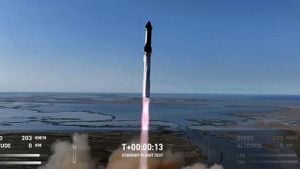China has made significant strides in enhancing its marine and environmental research capabilities with the successful launch of its first high-precision ocean salinity detection satellite, Ocean-4 01. The satellite was sent aloft on November 14, 2024, from the Taiyuan Satellite Launch Center located in Shanxi Province, marking yet another achievement for Chinese space endeavors.
The satellite was launched aboard a Long March 4B Y53 rocket at 6:42 AM Beijing Time and has already entered its predetermined orbit. This launch is noted as the 545th mission for the Long March rocket series, underscoring China's continuous efforts to expand its capabilities within space technology.
According to the China National Space Administration (CNSA), the new satellite aims to fill existing gaps in China’s monitoring of ocean salinity, thereby significantly enriching the nation’s ability to collect precise data on marine dynamics and environmental conditions. This enhancement will, in turn, facilitate the production of more accurate marine forecasting products.
Experts highlight the satellite's role in various sectors. For example, it is expected to bolster marine environmental forecasting, contribute to ecological assessments, and monitor the water-cycle. These advancements Play a pivotal role not only for oceanographic research but also support agricultural, meteorological, and disaster mitigation applications. The rich data this satellite gathers will be leveraged for short-term climate predictions and studies of global climate change.
The launch is part of China's broader strategy to bolster its oceanographic research capabilities amid changing global climate patterns. The CNSA emphasizes the satellite's potential impact on helping track pollution levels and enhancing marine navigation safety—an area of increasing importance as environmental concerns mount across the globe.
By deploying Ocean-4 01, China is not only strengthening its technological expertise but also showcasing its commitment to global climate research. With this satellite, data can be gathered on salinity levels and other marine factors at unprecedented precision, allowing scientists to observe phenomena such as ocean circulation patterns and ecosystem changes.
After its insertion, the satellite was confirmed to have achieved its operational orbit of approximately 633 by 644 kilometers. Notably, the satellite is equipped with advanced tools, including comprehensive aperture radiometers and active and passive detectors, which provides it with the capability to gather diverse marine data effectively.
This launch joins other significant aerospace milestones for China this year, which has seen 55 orbital attempts, including notable missions like the recent crewed missions on the Shenzhou spacecraft and the Chang’e-6 lunar mission, which returned samples from the moon’s far side.
Upcoming missions feature the Tianzhou-8 cargo supply mission to the Tiangong space station, set for launch shortly after the Ocean-4 01 satellite. The future endeavors highlight China's ambition to remain at the forefront of space exploration and research.
Ocean satellites play invaluable roles as they are equipped to provide real-time data for weather models and effectively monitor climate anomalies. The Haiyang series of satellites, which translates to ‘ocean’ in Chinese, share this overarching purpose and aim to provide comprehensive insights necessary for the management and preservation of marine environments.
This latest mission is hailed as not merely a technological advancement but as part of China’s initiative to provide greater contributions on the global stage, particularly adjacent to pressing issues like climate change. The data gathered through such satellites could inform not just Chinese policies but also global environmental strategies aimed at preserving ocean health and mitigating the impacts of climate change.
Overall, the launch of the Ocean-4 01 satellite is more than just technical proficiency; it symbolizes China's commitment toward innovative solutions for environmental monitoring, reaffirming its status as a key player on the international scientific stage.



